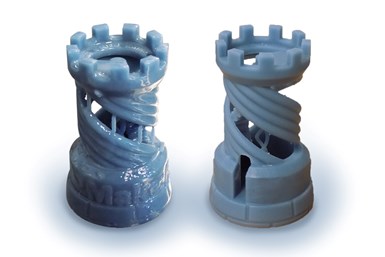PostProcess Develops Resin Removal System for Composites, Ceramics
The company says the PLM-405-SUB chemistry formulation removes both excess resin and ceramic filler residue from 3D printed parts simultaneously in one detergent.

Rooks before and after postprocessing. Photo Credit: PostProcess Technologies
PostProcess Technologies says its PLM-405-SUB solves postprinting challenges for composite and ceramic-filled resins by removing both excess resin and ceramic filler residue from 3D printed parts simultaneously in one detergent. The company developed this new solution for resin removal as a part of its offering of automated and intelligent additive manufacturing (AM) postprocess solutions.
The company says traditional resin removal for composite-filled resins, such as processing in IPA, results in a white chalky residue left on side walls and feature surfaces of the 3D printed part. That is said to typically require significant manual labor to scrub excess residue from parts after the initial resin removal step, which may inhibit the ability to scale up to production-level operations.
The PostProcess automated solution, including the new PLM-405-SUB chemistry formulation utilized in the DEMI 400 and DEMI 800 Series, is said to reduce the reliance on manual labor and ultimately reduce cycle times, process steps and typical operational risk factors associated with other solutions.
The company says the benefits of using PLM-405 in the resin removal workflow include deeper ultrasonic cleaning on intricate parts with fine features and crevices that are not suitable for cleaning with alternative methods. Also, as a part of PostProcess’ hardware, software and chemistry approach, its newest resin removal solution is said to achieve improved processing times and end part consistency.
Related Content
-
Carnegie Mellon Helps Industry, Students Prepare for a Manufacturing Future with AM and AI
Work underway at the university’s Next Manufacturing Center and Manufacturing Futures Institute is helping industrial additive manufacturers achieve success today, while applying artificial intelligence, surrogate modeling and more to solve the problems of the future.
-
Spherene Creates Metamaterial with Geometry Derived from Spheres
An algorithm developed by Spherene Inc. generates Adaptive Density Minimal Surfaces (ADMS) as a self-supporting infill strategy that can be used to reduce mass and manage material properties in 3D printed parts.
-
Decentralized Manufacturing Network Aims to Make 3D Printers a Shared Global Resource
The 3DOS additive manufacturing network will let OEMs and creators take advantage of open 3D printer capacity anywhere in the world.










